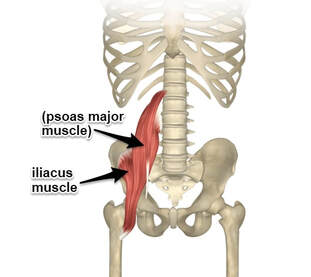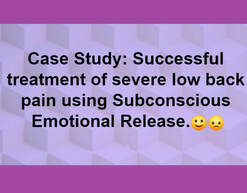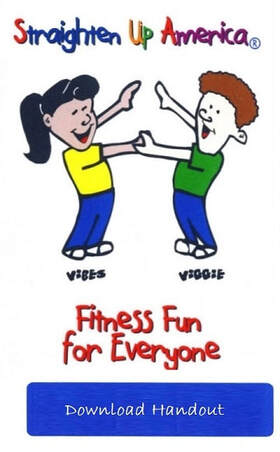|
9/25/2022 0 Comments Increase Neck Range of MotionDr. Kelley LeBlanc shows you Gentle Neck Movements to increase range of motion (Cervical ROM) and reduce pain. Do 1-3 times per day. Hold each position for one breath. If you have severe neck pain and fever, please go to the Emergency Room. If any movement causes intense pain, STOP and see your doctor.
0 Comments
8/6/2022 1 Comment Bring Love to the Table The word "Chiropractic" means "done by hand". I touch people, which I consider a real privilege. I use my hands to help bring a patient's body back into balance and I use my touch to help move their spirit toward health. I touch not only with my hands, but my ears, my eyes, my heart and my intuition. I am a keen observer. I can see the surface and the depth; the current and the past. I see patterns and ask "What has helped other people with this pattern?" I focus on the underlying issue. What is the most efficient way forward? I am a doctor, a cheerleader, a trainer and a fierce momma bear. This is a second career for me. I graduated from Chiropractic school at age forty seven. Before that I was a technical project manager for AT&T and IBM. I had wanted to become a chiropractor for many years but didn't want to move my daughter away from her dad. So when she went to college, I went back to college. I had been a chiropractic patient for many years. After my daughter was born in 1985, I had difficulty walking. Someone suggested chiropractic. It helped and I felt so much better that I kept getting adjusted once or twice a month for years and brought my daughter as well. As a chiropractic patient, I was adjusted by many different methods, from the typical cracking and twisting, to low force instruments, to zero-force energy-work. I found that gentle instrument adjusting using the Activator Protocol was what worked best for me. I'm a very sensitive and flexible person; my body needed a very gentle approach. After a typical Activator adjustment I would feel centered, lighter and more clear-headed. So naturally, in chiropractic school, I focused on Activator as my specialty. The Activator method is very analytical, very left brain: 1.) Test a reflex, 2.) See if it balances the body, 3.) Adjust in the direction of balance. Interestingly, I have noted that many advanced Activator practitioners develop intuition about which reflexes to test. And in my own practice, I've used the Activator Protocol to test my hunches. Because my intuition has been validated, over and over , I have developed faith in my intuitive sense, which is a real short-cut to the discovery of what the patient needs most. As a chiropractic patient, my favorite doctors used Applied Kinesiology (AK) to test what the patient needed. Applied Kinesiology is basically asking the body questions. What does that mean? Who are we asking? I have no idea. But I do know that it is in 100% agreement with the Activator Protocol, which is researched-based. I am not the first Activator doctor to discover this. Many of us believe that the reflex testing of Activator Protocol is, at root, Applied Kinesiology. Several years ago I realized that there is no limit to what you can ask the body via AK. However, the first question I always ask is, "Can I ask this question?" Sometimes the answer is "no" for whatever reason. Maybe it's not the right time to ask? In my practice, I use the Activator Method to do a thorough scan for spinal alignment then I use AK to ask about the alignment of every other bone in the body. I may follow up by asking if there is muscle imbalance, food sensitivity, toxicity, recommended exercises, if a referral would be best, etc.. Yesterday, my patient came in with severe buttock pain. Her M.D. had diagnosed piriformis syndrome, which is a form of sciatica. I used the Activator protocol to test the piriformis muscle. Negative, not the piriformis muscle. Then I used AK to ask her body "Is the sciatic nerve being irritated." (Yes), Is there physical pressure on the sciatic nerve?" (No). "Is there chemical irritation of the sciatic nerve." (No). [Chemical irritation of the nerve would include inflammation or toxicity.] I opened my intuition, asking for the right question. "Is this referred pain from the gut?" (Yes) "Is it from something she ate?" (Yes) I stepped into my intuitive brain again to search for the answer/question. My intuition said "Non-wheat pasta." I asked my patient, "Have you eaten non-wheat pasta in the last week?" She replied, "Yes I eat gluten-free and I have eaten corn-based pasta and rice-based pasta." I asked her body "Did the corn-based pasta cause the sciatic nerve irritation?" (Yes) "Does the rice-based pasta cause it?" (No). I recommended to my patient that she eliminate corn from her diet completely. I also recommended an ionic foot bath, which will help pull the organic "corn-toxin" from her body. Often, I'll open my intuition and find the question "Should we do energy work?" I have been doing energy work for thirty years. At first just learning on my own, then studying with various masters. Energy-work, at it's most fundamental is using your intuitive sense to connect to another, to feel them similar to "knowing" that someone just walked into the room. As a practitioner, my goal is to quiet my mind, and to allow love and connection to be present. That is deeply healing. This is a human skill that anyone can learn. I recommend that you experiment doing energy-work with your loved-ones and pets. There are only two rules: 1.) Do not donate your energy to another and 2.) Do not take energy from another. It is a practice in healthy boundaries and connection with love. No worries, if you bring love to the table you cannot go wrong. xxoo  Severe low back is often due to psoas and iliacus muscles spasm. These muscles are often referred to as "hip flexors", however they also bend and rotate the spine. A spasm of these muscles can recruit other muscles into spasm such as the abdominal muscles. This type of spasm often occurs after an injury, after overworking the low back muscles and also after sitting for an extended period of time such as in a car or plane. Typically, a person with a psoas spasm will feel better while sitting, then when they arise from a chair they may need two or three steps before then can straighten to standing. Often a patient will have one side that is in spasm. These patients will either be flexed laterally or have their shoulders quite dramatically off to one side in relation to where their hips are. About 60% of severe low back pain that I see in my Chiropractic office is due to low back muscle spasm. The psoas muscle is attached to the front of the vertebra and discs and can pull them out of place causing severe pain. A low back spasm can become chronic, so it is important to relax the muscle then improve core strength. Psoas and Iliopsoas Muscle Spasm Home Protocol 1.) Avoid Sitting especially long drives in car or on plane - If you must, don't drive and lean passenger car seat back as far as possible. 2.) Avoid walking long distances except around the house 3.) Wear a back brace if it helps 4.) Stretch Hip Flexor Muscles: Leg off side of bed, remember to bend opposite knee to protect/flatten low back curve. 5.) Do these Home Exercises to Align Your Sacroiliac Joints (2-3 x per day) to your comfort level. 6.) Gentle Core Exercises (2-3 x per day
8.) Heat on Low Back and/or Lower Abdomen:
10.) Try Muscle Relaxers:
-- Kelley LeBlanc, D.C. Kelley Chiropractic and Wellness Village at Wexford 1000 William Hilton Pkwy, Ste K100 Hilton Head Island, SC 29928 (843) 321-8119 If your pain is in buttocks and back of thigh, but does not go below the knee you may have Piriformis Syndrome. This happens when the piriformis muscle (one of the major buttocks muscles) presses on the sciatic nerve. Piriformis syndrome can be caused by the piriformis muscle being
a.) Too tight OR b.) Overstretched OR c.) Sprain/strained 1.) Reduce inflammation
2.) Gently Stretch
3.) Strengthen
4.) Balance Exercises
The above assumes piriformis muscle pressure on the sciatic nerve. Here are other common issues that could be causing sciatic-like pain.
Kelley LeBlanc, D.C. Kelley Chiropractic and Wellness Village at Wexford 1000 William Hilton Pkwy, Ste K100 Hilton Head Island, SC 29928 (843) 321-8119 4/20/2020 2 Comments Home Care Protocol for SciaticaSciatica: What is it and how is it treated? via Web MD
If you have 10/10 low back and or leg pain you may want to visit Moss Creek Orthopedic Urgent Care, (843) 836-7022 for an MRI, steroid injection, muscle relaxers and/or pain medication. Home Care Protocol for Sciatica: 1.) Avoid Sitting. Laying on your back removes pressure on the lumbar disc, standing is somewhere between. 2.) Don't lift more than 5 lbs. When you cough or sneeze, support yourself by holding a pillow on your stomach. 3.) Reduce inflammation and feed the disc
4.) Do NOT use heat on the low back. It might feel good, but it can exacerbate inflammation, making you worse. 5.) If you have very acute low back pain 9-10/10 try this: Extreme Low Back Pain, Sciatica, Disc Herniation - Gentle Traction 2 - 3x per day or more 6.) If you can do #5 with ease try this: Gentle Knee to Chest Stretches for Low Back Arthritis 2 - 3 x per day or more 7.) If you can do #6 with ease try this for 10 minutes, 2 - 3 x per day or more: Lay with your back on a (cushioned) floor with your feet over an ottoman. 8.) If you can do # 7 with ease try this 10 minutes, 2 - 3 x per day or more: Lay on your back with your feet up the wall...You do NOT need to straighten your legs on the wall. #7 and #8 - These stretches gently traction the low back and send fresh healing blood to the area of injury. They are very simple but highly effective. There is no upper limit on how long you can stay in this position, but stay for at least 10 minutes 2-3x/day. 9.) If your sciatica is caused by a disc injury, you might feel better before the disc is healed. Remember reinjuring an already injured disc can get you into real trouble. A disc that might have healed in a few weeks could be reinjured and could take 6 months to a year to recover. The above assumes a disc injury. Here are other common issues that could be causing sciatic-like pain.
Kelley LeBlanc, D.C. Kelley Chiropractic and Wellness Village at Wexford 1000 William Hilton Pkwy, Ste K100 Hilton Head Island, SC 29928 (843) 321-8119 11/8/2019 2 Comments Case Study: Successful treatment of severe low back pain using Subconscious Emotional Release. 11/8/19 Case Study: Successful treatment of severe low back pain due to spasm using chiropractic and Subconscious Emotional Release. Female patient with constant severe low back pain (LBP). Used supine relative leg length analysis to ask yes/no questions. We established that for her, while supine, her the right leg becoming short meant "Yes". Legs staying even meant "No". Since a patient has no conscious control over leg length, it is assumed the answers to these questions come at a subconscious level. The following questions were asked:
Continued to determine several factors:
Those factors as well as eye placement, touch on meridian points and breath were used to stimulate multiple neuro pathways at once. The goal is to weaken/unlock the underlying subconscious neuro pattern to allow feeling(s) to arise, so that they can be processed. The unlocked subsconscious pattern can also be processed via dreams. Post Adjustment: Patient had 0/10 pain and was able to move normally. 8/15/2019 0 Comments Mind/Body Emotional Release (MBER) Over the course of my training and practice as a chiropractor, and through my own personal search for peace, I have learned and been exposed to many mind/body and energy techniques. They seem to be converging now and morphing into something of my own. This most recent development was triggered by my new colleague, Dr. Jack O'Hea, who introduced me to Bio-Energetic Synchronization Technique (B.E.S.T.) which I find powerful. But from the start of learning B.E.S.T. I knew that I would be using it as a jumping off point. So now, I introduce to you: Mind/Body Emotional Release (MBER). Mind/Body Emotional Release (MBER) identifies unresolved, recurring thoughts, emotions, or body sensations.These persistent neurological patterns can cause stress ranging from tight muscles to PTSD. Objective measures are used to identify specific factors that stimulate cortical, sensory, motor, and lymbic pathways of the brain, to "short-circuit" unresolved neurological pathways. Mind/Body Emotional Release draws on multiple methods designed to interrupt detrimental neurological patterns. These include Bio-energetic Synchronization Technique (BEST), Reconnective Healing, Logan Basic Technique, Applied Kinesiology, Acupuncture, Polarity Therapy, Craniosacral Therapy, Eye Movement Desensitization and Reprocessing (EMDR), Somatic Experiencing Technique, and Emotional Freedom Technique (EFT). Two simple exercises to reverse foot pain. Arch support is not the answer for weak arches. Foot strength is. Think about it: every muscle of your body needs to be strong and flexible. Wearing arch supporting shoes all the time is similar to wearing a back brace too much ... it weakens your feet. Practice these exercises 2 to 3 times a day for a few minutes for one year and you will cure bunions, plantar fasciitis, and hammer toes. Just play with your feet using these exercises and you will not only save your feet but you will create a strong foundation for your knees, hips, back, etc!! Get your feet a chiropractic adjustment regularly and your feet will thank you even faster! Schedule online now at www.ChiroKelley.com 7/22/2019 1 Comment 5 Exercises for Back Spasm ReliefMost severe back pain is due to muscle spasm. Do these exercises 3 to 4 times per day. If any of these movements are uncomfortable, back off to the point that they are easy. If you can't do any of these movements, come see us. We can diagnose the underlying cause of your back pain. Book online now. |
Archives
September 2022
CategoriesAll Activator Allergy Anxiety Applied Kinesiology Autoimmune Disease Back Pain Back Spasm Blood Pressure Breastfeeding Bunions Cancer Cancer And Sprit Chiro Saves Money Depression Disc Disease Energy Work Flu Foot Pain Green Smoothies Gut Health Healthy Boundaries Heart Disease Hip Flexor Home Care Hormone Disruptors Immune Strength Juicing Kidney Liver Love Neck Pain Newborn Nutrition Piriformis Syndrome Posture Protein And Diet Psoas Reiki Scar Reduction Sciatica Second Career Skincare Sleep Spinal Arthritis Stand Up Desks Stress Stroke Traction Types Of Stress Yoga Sandals |


